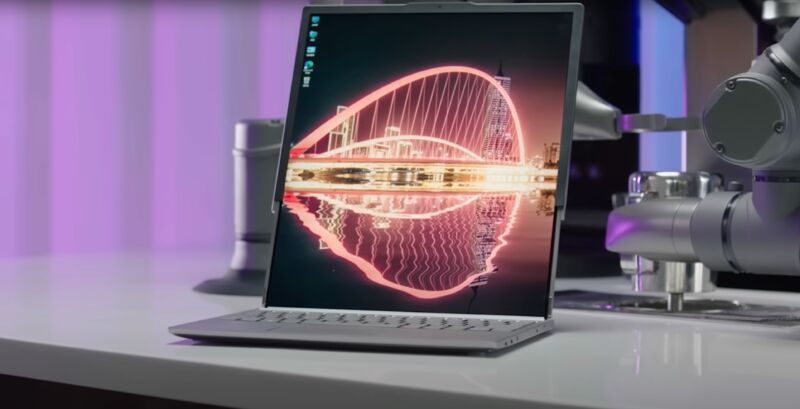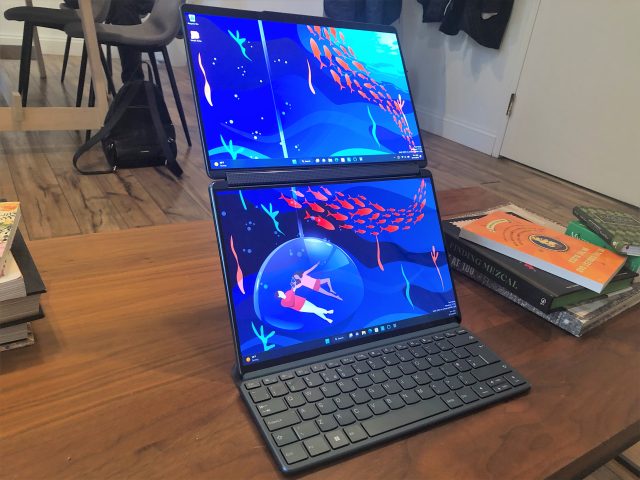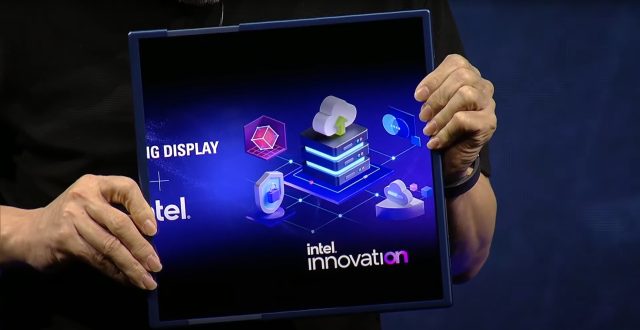
Lenovo's 12.7 to 15.3-inch roll-up laptop is just a proof-of-concept, but it looks pretty serious. The company first sold an all-in-one OLED laptop online in October but showed it off in person ahead of the Mobile World Congress in Barcelona this week. Featuring an OLED display in two different sizes and resolutions, it's described as thin and decently glossy.
As a proof of concept, Lenovo may never release a computer with such a rollable screen. However, the company told Windows Central that it prefers to "develop concepts that we hope to sell." In addition, this is not the first time Lenovo has released laptops with an alternative screen design. Its 2020 ThinkPad X1 Fold was the first to test a foldable computer, and the 16-inch ThinkPad X1 Fold will follow this year. Also due this year is the Lenovo Yoga Book 9i, which combines two 13.3-inch OLED screens on a single hinge.

In its current form, the floating-screen laptop prototype "looks and feels like a regular laptop," according to the Android Authority. The post was also supportive of Lenovo, calling the prototype "finished" enough to show it to you. He even thought the system looked less bulky than the Asus ZenBook 17 Fold, a 12th-generation Intel-based foldable computer that costs $3,500.
The swivel screen Lenovo laptop display sits on a ThinkBook chassis, one of Lenovo's more experimental laptop lines. The Verge said the prototype panel is made by Sharp, which makes foldable screens for the ThinkPad X1 Fold and the upcoming 16-inch ThinkPad X1 Fold.
The prototype screen may display 2024×1604 pixels in a 12.7 inch size with a 4:3 aspect ratio or 2024×2368 pixels in a 15.3 inch size with an 8:9 aspect ratio. The pixel density remains almost the same in both scenarios (203.4 and 203.6 pixels per inch, respectively).
That alone is worth a break. While premium options are moving away from 16:9 in favor of 16:10 and larger screens, near-square screens are rare among laptops. Users praised the longer screens for their classic feel and accessibility for computing tasks such as viewing comprehensive news and social media feeds, spreadsheets and articles, programming, and multitasking.
Lenovo's prototype looks different than what's currently available in laptops. The 8:9 aspect ratio is like stacking two 16:9 screens on top of each other (Yoga Book 9i has two 16:10 screens). A laptop can offer unique side-by-side portraiture capabilities. In a conversation with Android Authority, Lenovo pointed to ThinkPad X1 Fold users who often use the device in portrait mode.
In the current form of the concept, getting from point A to point B means flipping a switch on the laptop's circuit board, enduring an uncomfortable wait of about 10 seconds (as measured by The Verge) and whirring motors. The tech advisor said the machine also uses springs and rails to adjust the display, but Lenovo may end up opting for a "manual scroll" version.
Since it hides part of the laptop's screen under the keyboard, the final laptop may have a better design than expected from a 15-inch class computer. The Verge stated that they were not allowed to lift the prototype or know its weight. However, the system is said to feel a bit thicker on average.
The proof of concept is still here. Tech Advisor reported that if an OLED display is slid under the keyboard, its pixels remain illuminated. The Verge also highlighted the prototype crease when the screen was at its maximum size, "where the screen initially folds under the keyboard" .
Durability is also under development and Lenovo is reportedly planning to use 20,000-30,000 rolls. It's also unclear how much battery the slider mechanism consumes.
Still, it's not hard to imagine a world where this is a real product, Lenovo or not. LG's $100,000 foldable TV works the same way, hiding the OLED screen when you don't need it. Flexible TVs and monitors have also sometimes attracted users who want a curved screen rather than a flat one.
And if Lenovo doesn't release a PC with a hidden display, someone else will probably do so, as PC and chip makers have been looking to redesign PC displays for years.
Last fall, Samsung Display and Intel showed off a concept PC that was a 13-inch tablet that could become a 17.3-inch tablet.

Earlier this year, Samsung Display also introduced the Flex Hybrid, a sliding OLED display that can be folded in half and displayed as a 10.5-inch 4:3 aspect ratio display or slide up to a 12-inch 16:10.4-inch screen.
With flexible window management that Windows 11 predecessors lacked, foldable PCs seem poised to become an almost niche product category.
There are many experiments and prototypes going on with OLED-based foldable laptops these days, and buyers will be able to quickly try or drop the effort.


.png)
Post a Comment
Post a Comment